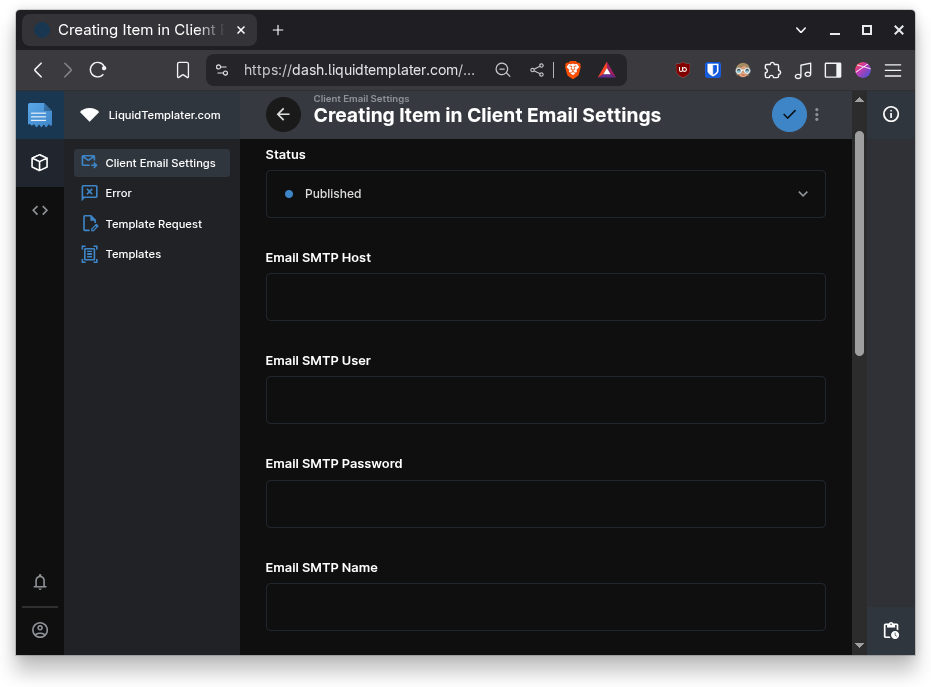Before you can send emails to external recipients through our API, you need to configure your SMTP credentials in the dashboard. Without SMTP configuration, rendered emails can only be sent to your own email address for testing purposes.
Setting up your own SMTP credentials gives you full control over email delivery and sender reputation. You can send rendered emails to any recipient once your SMTP settings are properly configured.
Log in to your dashboard
Sign in with your credentials.
Navigate to Email Settings
Go to the Client email settings page.
Add a new entry
Go toadd a new SMTP entry.
Create or Edit Your SMTP Configuration
You'll see a form with several fields that need to be configured for your email provider.
 Each field in the configuration corresponds to standard SMTP connection parameters. Here's what each setting controls:
Each field in the configuration corresponds to standard SMTP connection parameters. Here's what each setting controls:
SMTP Host (email_smtp_host)
The hostname or IP address of your email provider's SMTP server. This is where our service will connect to send your emails.
SMTP User (email_smtp_user)
Your SMTP username, typically your email address or a specific username provided by your email service.
SMTP Password (email_smtp_password)
The password or app-specific password for your SMTP account. Many providers require app passwords instead of your regular account password.
SMTP Name (email_smtp_name)
The "From" name that appears in sent emails. This is often formatted as an email address but represents the sender identity.
SMTP Port (email_smtp_port)
The port number your SMTP server uses. Common ports are 587 (recommended), 465, or 25.
Connection Security Settings
email_smtp_secure): Check this box to enable SSL/TLS encryption from the start of the connectionemail_smtp_require_tls): Check this box to enforce TLS encryption during the connectionemail_smtp_ignore_tls): Leave unchecked unless your provider specifically requires bypassing TLSSMTP Pool (email_smtp_pool)
Check this box to enable connection pooling for higher volume email sending. Leave unchecked for standard usage.
SMTP Host: smtp.gmail.com
SMTP Port: 587
SMTP User: your-email@gmail.com
SMTP Password: [App Password - not your regular password]
SMTP Name: your-email@gmail.com
SMTP Secure: unchecked
Require TLS: checked
Ignore TLS: unchecked
SMTP Host: smtp.sendgrid.net
SMTP Port: 587
SMTP User: apikey
SMTP Password: [Your SendGrid API Key]
SMTP Name: noreply@yourdomain.com
SMTP Secure: unchecked
Require TLS: checked
Ignore TLS: unchecked
SMTP Host: smtp.mailgun.org
SMTP Port: 587
SMTP User: postmaster@your-domain.mailgun.org
SMTP Password: [Your Mailgun SMTP Password]
SMTP Name: noreply@yourdomain.com
SMTP Secure: unchecked
Require TLS: checked
Ignore TLS: unchecked
SMTP Host: mail.smtp2go.com
SMTP Port: 2525
SMTP User: your-username
SMTP Password: [Your SMTP2GO Password]
SMTP Name: noreply@yourdomain.com
SMTP Secure: unchecked
Require TLS: checked
Ignore TLS: unchecked
Don't Have an SMTP Provider Yet?
We've had good experience with SMTP2GO for reliable delivery. Any reputable provider from the examples above will work fine with our service.
After saving your SMTP settings, the system will validate the connection during your first email render request. If there are connection issues, you'll receive an error response indicating the specific problem (authentication failure, connection timeout, etc.) to your account's email address
You can test your configuration by making a simple email render request through the API. Or by using the GUI Template editor/tester The system will attempt to connect to your SMTP server using the provided credentials, if not successful we will email your account's email address a detailed error report.
The choice of SMTP port affects how the connection is established:
Port 587 (Recommended)
Uses STARTTLS, which begins as an unencrypted connection and upgrades to TLS. Most modern email providers prefer this approach.
Port 465
Uses implicit SSL/TLS, meaning the connection is encrypted from the start. Check the SMTP Secure box when using this port.
Port 25
Standard SMTP port, often blocked by ISPs and hosting providers. Generally not recommended for modern applications.
App Passwords
Most major email providers (Gmail, Outlook, etc.) require app-specific passwords instead of your regular account password. Generate these through your email provider's security settings.
API Keys vs Passwords
Services like SendGrid and Mailgun use API keys instead of traditional passwords. These provide better security and can be easily revoked if compromised.
Connection Encryption
Always check the Require TLS box unless your provider specifically doesn't support it. This ensures email content is encrypted during transmission.
Authentication Failures
Verify your username and password are correct. Check if your email provider requires app passwords or API keys instead of regular passwords.
Connection Timeouts
Ensure the SMTP host and port are correct. Some hosting environments block certain SMTP ports.
TLS/SSL Errors
Try different combinations of the security settings. Some providers require specific TLS configurations.
Rate Limiting
If you're sending high volumes, check the SMTP Pool box and ensure your email provider supports your sending rate.
The SMTP configuration uses standard nodemailer transport options under the hood. For complex setups or custom requirements, you can reference the underlying connection parameters in the nodemailer SMTP documentation for additional context on these settings.
If you need custom integrations, dedicated infrastructure, or enterprise-level support for your SMTP configuration, please reach out to our team to discuss your specific requirements.
Our system automatically monitors all email processing requests and maintains detailed error logs. If we encounter any issues processing your email renders or SMTP connections, you'll receive an email notification at your account email address explaining the specific problem and suggested solutions.
Common notifications include SMTP authentication failures, connection timeouts, or configuration errors. These automated alerts help you quickly identify and resolve any issues with your email sending setup.